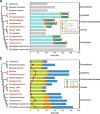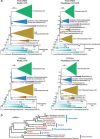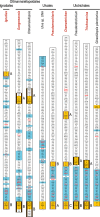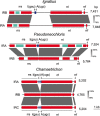Divergent copies of the large inverted repeat in the chloroplast genomes of ulvophycean green algae
- PMID: 28428552
- PMCID: PMC5430533
- DOI: 10.1038/s41598-017-01144-1
Divergent copies of the large inverted repeat in the chloroplast genomes of ulvophycean green algae
Abstract
The chloroplast genomes of many algae and almost all land plants carry two identical copies of a large inverted repeat (IR) sequence that can pair for flip-flop recombination and undergo expansion/contraction. Although the IR has been lost multiple times during the evolution of the green algae, the underlying mechanisms are still largely unknown. A recent comparison of IR-lacking and IR-containing chloroplast genomes of chlorophytes from the Ulvophyceae (Ulotrichales) suggested that differential elimination of genes from the IR copies might lead to IR loss. To gain deeper insights into the evolutionary history of the chloroplast genome in the Ulvophyceae, we analyzed the genomes of Ignatius tetrasporus and Pseudocharacium americanum (Ignatiales, an order not previously sampled), Dangemannia microcystis (Oltmannsiellopsidales), Pseudoneochloris marina (Ulvales) and also Chamaetrichon capsulatum and Trichosarcina mucosa (Ulotrichales). Our comparison of these six chloroplast genomes with those previously reported for nine ulvophyceans revealed unsuspected variability. All newly examined genomes feature an IR, but remarkably, the copies of the IR present in the Ignatiales, Pseudoneochloris, and Chamaetrichon diverge in sequence, with the tRNA genes from the rRNA operon missing in one IR copy. The implications of this unprecedented finding for the mechanism of IR loss and flip-flop recombination are discussed.
Conflict of interest statement
The authors declare that they have no competing interests.
Figures







Similar articles
-
Mitochondrion-to-Chloroplast DNA Transfers and Intragenomic Proliferation of Chloroplast Group II Introns in Gloeotilopsis Green Algae (Ulotrichales, Ulvophyceae).Genome Biol Evol. 2016 Sep 19;8(9):2789-805. doi: 10.1093/gbe/evw190. Genome Biol Evol. 2016. PMID: 27503298 Free PMC article.
-
Flip-flop organization in the chloroplast genome of Capsosiphon fulvescens (Ulvophyceae, Chlorophyta).J Phycol. 2019 Feb;55(1):214-223. doi: 10.1111/jpy.12811. Epub 2018 Dec 18. J Phycol. 2019. PMID: 30403403
-
The chloroplast genomes of the green algae Pedinomonas minor, Parachlorella kessleri, and Oocystis solitaria reveal a shared ancestry between the Pedinomonadales and Chlorellales.Mol Biol Evol. 2009 Oct;26(10):2317-31. doi: 10.1093/molbev/msp138. Epub 2009 Jul 3. Mol Biol Evol. 2009. PMID: 19578159
-
Chloroplast genomes of photosynthetic eukaryotes.Plant J. 2011 Apr;66(1):34-44. doi: 10.1111/j.1365-313X.2011.04541.x. Plant J. 2011. PMID: 21443621 Review.
-
The concept of the genus Ulothrix (Chlorophyta) strengthened by comparative cytology.Biosystems. 1985;18(3-4):357-68. doi: 10.1016/0303-2647(85)90035-8. Biosystems. 1985. PMID: 3910140 Review.
Cited by
-
Neoproterozoic origin and multiple transitions to macroscopic growth in green seaweeds.Proc Natl Acad Sci U S A. 2020 Feb 4;117(5):2551-2559. doi: 10.1073/pnas.1910060117. Epub 2020 Jan 7. Proc Natl Acad Sci U S A. 2020. PMID: 31911467 Free PMC article.
-
Molecular Phylogeny of Unicellular Marine Coccoid Green Algae Revealed New Insights into the Systematics of the Ulvophyceae (Chlorophyta).Microorganisms. 2021 Jul 26;9(8):1586. doi: 10.3390/microorganisms9081586. Microorganisms. 2021. PMID: 34442668 Free PMC article.
-
Novel insights into chloroplast genome evolution in the green macroalgal genus Ulva (Ulvophyceae, Chlorophyta).Front Plant Sci. 2023 Apr 18;14:1126175. doi: 10.3389/fpls.2023.1126175. eCollection 2023. Front Plant Sci. 2023. PMID: 37143870 Free PMC article.
-
airpg: automatically accessing the inverted repeats of archived plastid genomes.BMC Bioinformatics. 2021 Aug 21;22(1):413. doi: 10.1186/s12859-021-04309-y. BMC Bioinformatics. 2021. PMID: 34418956 Free PMC article.
-
Plastid phylogenomics with broad taxon sampling further elucidates the distinct evolutionary origins and timing of secondary green plastids.Sci Rep. 2018 Jan 24;8(1):1523. doi: 10.1038/s41598-017-18805-w. Sci Rep. 2018. PMID: 29367699 Free PMC article.
References
-
- Lang, B. F. & Nedelcu, A. M. In Genomics of Chloroplasts and Mitochondria Vol. 35 Advances in Photosynthesis and Respiration (eds Ralph Bock & Volker Knoop) Ch. 3, 59–87 (Springer Netherlands, 2012).
-
- Jansen, R. K. & Ruhlman, T. A. In Genomics of Chloroplasts and Mitochondria Vol. 35 Advances in Photosynthesis and Respiration (eds Ralph Bock & Volker Knoop) Ch. 5, 103–126 (Springer Netherlands, 2012).
-
- Brouard JS, Otis C, Lemieux C, Turmel M. Chloroplast DNA sequence of the green alga Oedogonium cardiacum (Chlorophyceae): unique genome architecture, derived characters shared with the Chaetophorales and novel genes acquired through horizontal transfer. BMC Genomics. 2008;9:290. doi: 10.1186/1471-2164-9-290. - DOI - PMC - PubMed
Publication types
MeSH terms
LinkOut - more resources
Full Text Sources
Other Literature Sources
Molecular Biology Databases

